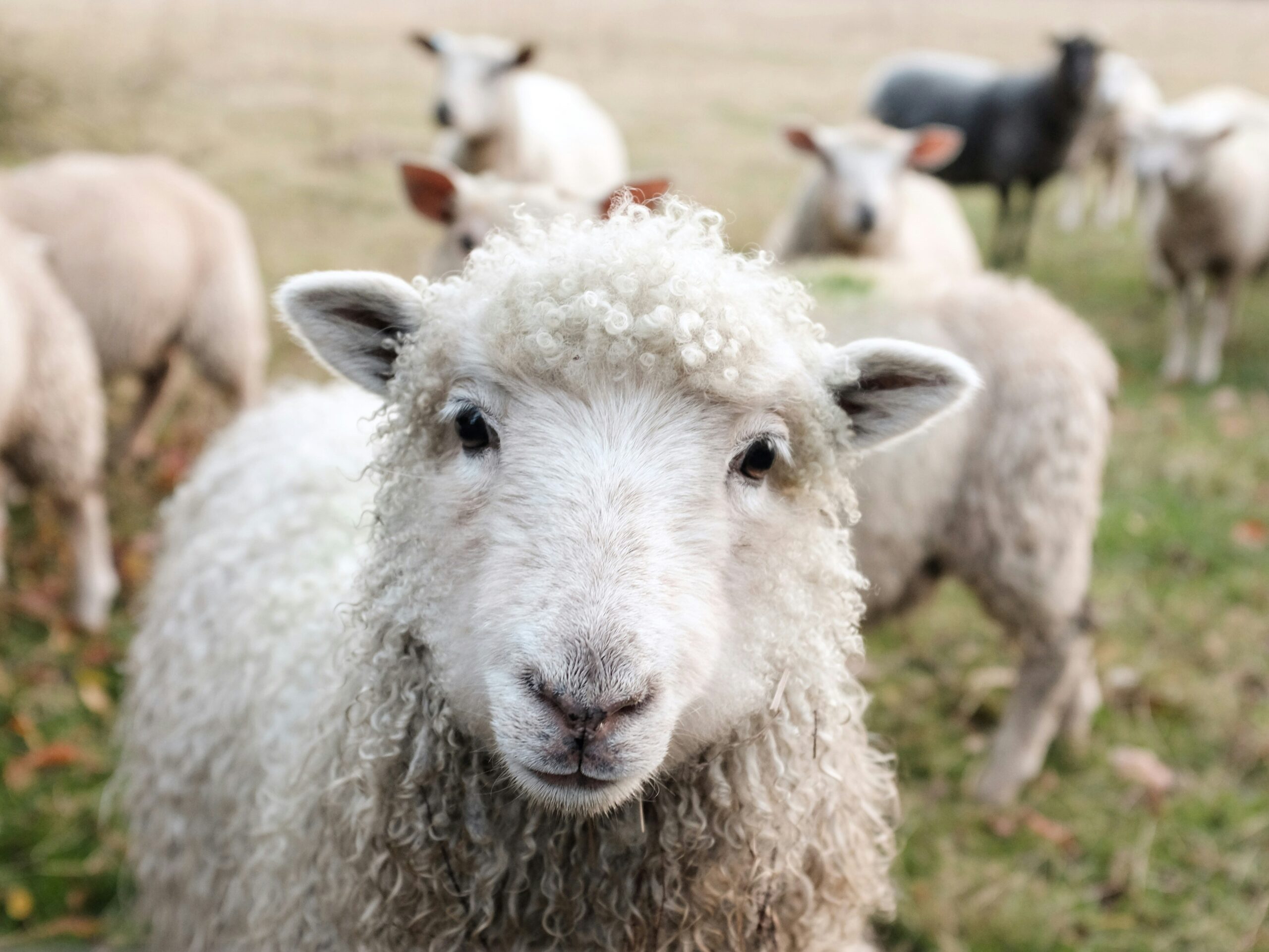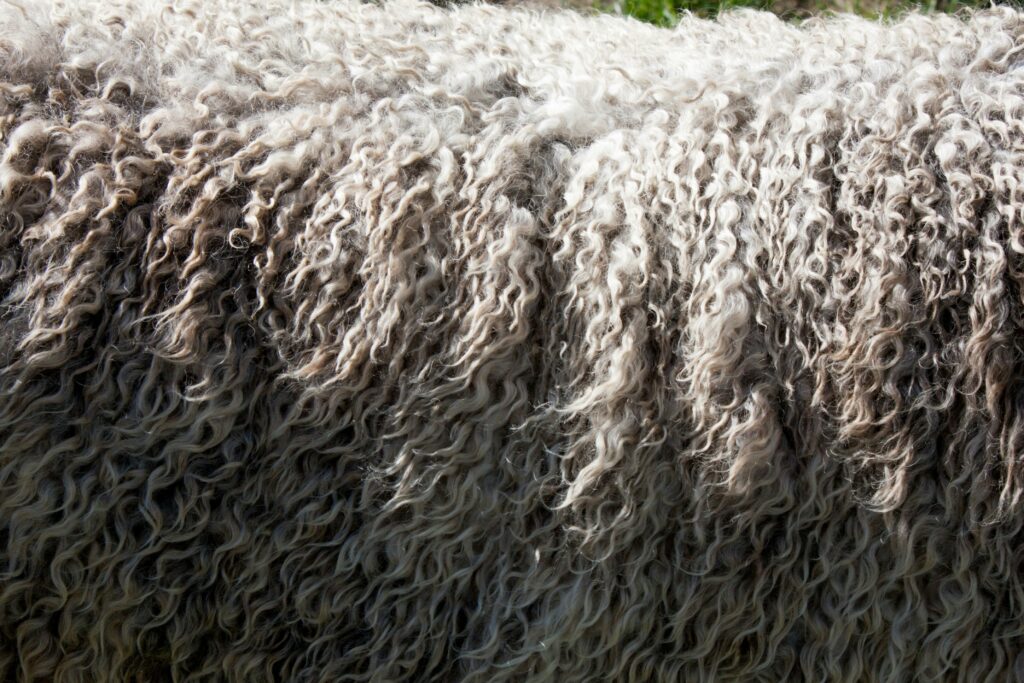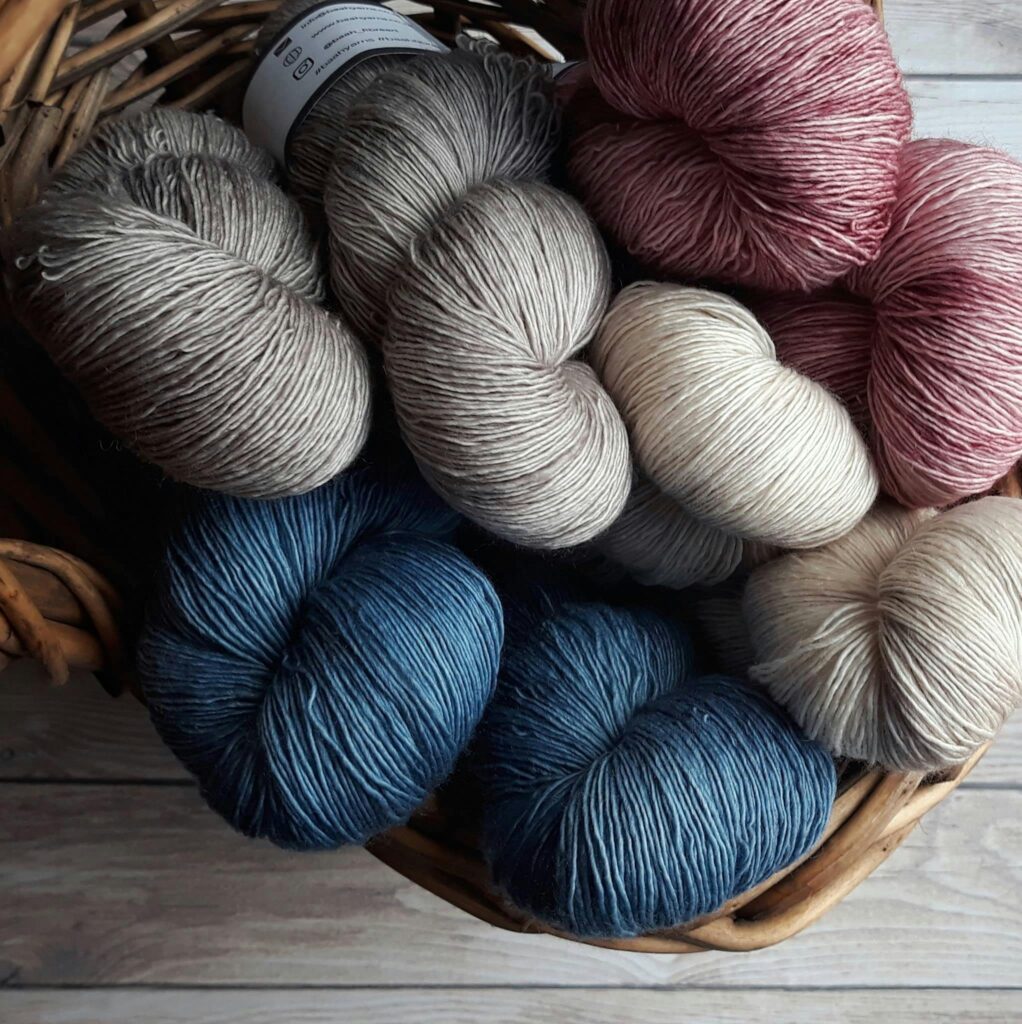
In recent years many people have rediscovered the joys of old-fashioned crafts, from knitting to woodwork. Home wool processing – turning raw fleece into clean fibre – is one such traditional skill enjoying a revival. It ties in with modern values of sustainability, local production and hands-on family fun. After all, wool is naturally 100% renewable, biodegradable and recyclable, making it an eco-friendly fibre. Supporting home-grown wool also supports British farmers and artisans, helping to preserve cherished heritage skills. At Greenfield Farm, we celebrate those traditions: each fleecing, washing and spinning step connects us to centuries of UK farming heritage.
Understanding Raw Wool
When a sheep is freshly sheared, its fleece is nothing like the soft yarn you might imagine. Raw fleece is weighed down with lanolin, the natural oil sheep produce. It feels greasy and smells strongly of wool grease. The photo below shows wool still on the sheep after shearing – you can see its greasy, crinkly locks. A more detailed view of a raw fleece reveals straw, dirt and even bits of manure tangled in the fibres. In other words, it’s very much “not fluffy and white” until it’s cleaned.
Different sheep breeds yield very different types of wool. For example, Merino sheep (a fine-wool breed) have very short, crimpy, soft fibres (micron count around 18–22), whereas longwool breeds like Romney produce longer, stronger staples with natural sheen. Hill breeds (like Cheviot or Wensleydale) may have medium-length, springy fibres that drape well. There are even natural wool colours from sheep – jacob or shetland fleeces come in greys, browns or blacks. In short, every fleece will feel and handle differently, but the basic cleaning steps are the same for all breeds.

Basic Steps of Home Wool Processing
- Skirting. The very first step is to skim off the dirtiest edges of the fleece. Lay the fleece out flat and trim away any stained or coarse parts. Pull off vegetable matter (straw, seeds, bits of grass) and sticky manure tags from the edges. Think of this like panning for gold: pick out and remove anything you definitely don’t want in the wash (sticky dung locks, very short or broken fibres, stained tips). The cleaner you can make it now, the easier the wash will be.
- Washing (Scouring). Next, wash the fleece in warm, soapy water to remove lanolin (grease) and dirt. Use a large plastic tub or sink. Fill with hot water (around 55–60 °C) and add a mild detergent or a specialty wool soap. Gently lay in a section of fleece – do not agitate or churn it, which would make it felt. Let the wool soak (say 15–20 minutes) so the grease dissolves. When draining, do so carefully through a colander or strainer – do not squeeze the wool, just let gravity pull the water out. Repeat the hot-soak with fresh soapy water until most of the greasiness is gone. Between soaks you can simply replace the water. Finally rinse: immerse the fleece in clean hot water (no soap) and soak again, repeating until the rinse water is clear and the wool feels clean (no cloudy ‘tacky’ residue). In short, hot water + gentle detergent + minimal handling will clean a fleece without felting.
- Drying. After washing, spread the wool out to dry on a mesh screen or rack, preferably outdoors in a shaded breeze or in a well-ventilated room. Don’t put wet wool in a hot tumble dryer (it could shrink or felt). Instead, let gravity drain the water, then use a gentle fan or move it to fresh air. Once dry, the wool should feel light, airy and free of dirt. Proper drying prevents mildew or rot and makes the next steps much easier.
- Picking and Carding. With clean fleece, the next task is to align the fibres for spinning or felting. If the fleece still has locks (tufts of fibre), pick or tease them apart by hand to open them up. Then use carders or combs to further line up the fibres. Carders (two brushes held together) pull the fibres into a loose “batt” or roll. Combs (like big metal dog combs) are used for very long wool to make a smooth top. In either case, the goal is to separate the fibres and remove remaining tiny bits of rubbish. You can use just hand carders if that’s all you have – they work nicely on medium-length wools and give a fluffy, lofty rolag (a roll of carded wool). The photo below shows a reenactor gently carding wool by hand: note how the fibres are becoming aligned and cleaned.
A reenactor carding wool with hand carders. Carding aligns the fibres into a smooth batt or rolag, ready for spinning or felting.
If you have longer wool or want a denser yarn, you can comb instead: hold two combs together and work through the locks, which creates a smoother, more parallel top. (Either method is fine for beginners – cards give a puffier, elastic yarn, combs make a sleek, strong yarn.) After carding/combing, your wool is ready to spin. Beginners can start with a simple drop spindle: grab a little rolag or fibre, hook it to the spindle, then spin it around to add twist. As it twists, the wool locks together into yarn. When you have a tail of yarn, hang it from a chair-back to add more twist, then wind it on. Learning spindle spinning is quite easy with online tutorials. Once you have yarn, you can knit, crochet or weave with it – but even if you never spin, carded wool is useful for crafts like felting (see below).
Tips for Families and Beginners
- Get the kids involved safely. Wool processing can be a fun family project. Young children (5–10 years old) can help pull out visible bits of straw or sort wool by colour. The gentle brushing of carders is even used in some schools as a calming handcraft. There are child-size hand carders available that fit little hands comfortably. Older kids can use drop spindles (they are cheap and safe) to try spinning under supervision. Always keep hot water, detergents and sharp tools (like the points of hand-combs) away from unsupervised play. Let children handle fibres on a table rather than on the floor to keep things tidy. Carding or gently pulling fibres can be almost like a sensory play: with kids cradling the wool in their hands (we scrub it gently, not throw it around), they learn about textures and stages of cleaning.
- Equipment and safety. You don’t need fancy machinery to start. A big plastic bucket or the kitchen sink works fine for washing. Use a laundry filter or strainer over the drain to catch stray fibres. Always put the fleece in after filling the tub with water so it gradually gets wet (this avoids shocking it). A dust mask can help if you’re sensitive to lanolin. Wool wash (like Eucalan or Synthrapol) is ideal, but mild dish soap also works for grease. Wear old clothes and rubber gloves if you like – the lanolin can be slippery. After washing, gently shake the wool to fluff it as it dries (but don’t tumble it). For carding, buy a pair of medium-firm hand carders (about £20 pair) – they’re a one-time purchase that last years. If you want to spin yarn, a beginner drop spindle is a great start (only about £20) before investing in a spinning wheel. No matter what, move slowly and gently when fibres are wet to avoid felting. If you’ve used very hot water, give everything a careful dry-out; and as always, supervise children closely during the washing stage.
- Learning resources. There are plenty of free guides and videos for each step. For example, spinners often advise: “Fill the machine or tub before adding the fleece. Use very hot water and soak – do not agitate”, to avoid felting the wool. Once you’ve washed and dried the wool, practice carding slowly: stroke wool locks between the carders in the direction of the fibre (similar to combing hair). Let the kids watch and ask questions – they love hearing how “people used to do this every day.” Remember, it’s a craft project – if a little bit of wool felts or ends up needing another quick wash, that’s okay. It’s part of learning!

What You Can Do with Home-Processed Wool
Now that you have clean, carded wool, the creative possibilities are vast. Here are some ideas:
- Felting projects. Unspun wool is perfect for felting. For wet felting, lay out layers of carded wool, sprinkle with warm water and a little soap, then agitate it by rubbing until it mats into a solid sheet. You can make felted balls, coasters, or even bowls this way. For needle felting, use short, barbed needles to poke the wool into shapes – great for making cute toys or decorations. Wool felts beautifully into dense, sturdy fabric because the fibres lock together.
- Spinning and yarn. With a spindle or wheel, spin your prepared wool into yarn. Hand-spun woollen yarn (from carded wool) is bouncy and warm – ideal for knitting hats, scarves or chunky blankets. Even simply twisting pairs of yarns together (plied yarn) will give you strands you can weave or knit. Remember that natural wool colours come in lovely earthy tones – creams, greys, browns and blacks – depending on your sheep. You can create patterns by blending different colours of fleece before carding. If you do spin and knit, you’ll be wearing something truly special, with every stitch made from the sheep in your own care.
- Crafting and home uses. Families can also do simple crafts: roll lengths of wool into felt balls (wet-felt around a core), make wool dryer balls to soften laundry, or weave wool yarn into small rugs or wall hangings. The children can help roll balls or make wool pendants. The lanolin you removed can even be saved – a bit of this natural oil is great for homemade wool wash or leather conditioner. Leftover shorn locks (post-skirting) can go onto compost or mulch if you have space, closing the loop on sustainability.
Overall, home-processed wool becomes a new material in your hands, ready for traditional crafts or modern DIY. As one wool guide notes, “you can get natural undyed wools in some lovely whites, creams, greys and browns depending on the breed” – so even without chemical dyes you have a palette of colours to work with.
Closing Thoughts
We hope this guide inspires you to give wool processing a try. It connects us to a rich British tradition: wool and sheep have shaped our landscapes and culture for millennia. By washing, carding and spinning just a fleece or two at home, you’re keeping that craft alive. Supporting these practices, as one crafts advocate puts it, “preserves important traditional skills… and ensures that the rich legacy of British craftsmanship continues to thrive”.
Whether you’re a local walking around our fields, a family on holiday, or a craft enthusiast looking for a new hobby, we welcome you to celebrate wool in all its forms. Home-processed wool is practical and poetic – a warm reminder that slow, mindful craft still has a place in our busy world. So roll up your sleeves (or hand-carders), enjoy the earthy aroma of lanolin, and savour the timeless satisfaction of making something by hand.


